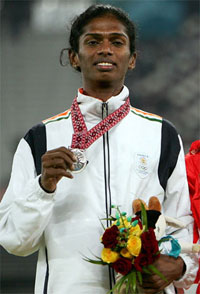女子項目進入奧運會�,無疑是現代奧運歷史上的一次進步�。然而在接下來的30多年里,接連發(fā)生了幾起令人匪夷所思�、啼笑皆非的性別混淆案。1966年�,性別檢測正式出現在國際體育比賽中。1968年第19屆墨西哥城奧運會上�����,國際奧委會首次對女性運動員進行了性別測試����,即染色體檢測。其目的就是為了消除競賽中以假冒女性身份贏得比賽的欺騙行為����,維護奧運會女子比賽的公平性。但近年來在各方面的壓力下�,自2000年悉尼奧運會取消了這種例行檢測,女運動員不再強行被進行性別測試����,但在有可疑情況存在的前提下必須進行測試。

|
|
Daha Asian Games silver medallist Santhi Soundarajan of India had failed a sex test .
|
At the Olympic Games in Atlanta, about 3,500 women athletes had to undergo a diagnostic procedure that most medical authorities have characterised as misleading and unnecessary: a sex test aimed at verifying that they are not males masquerading as females. The aim, obviously, is to ensure that males, with their naturally androgen-enhanced muscular strength, don't compete against females in women-only contests. But most medical experts say that the test is far more likely to bar unfairly from competition women with genetic abnormalities that confer no such advantages.
Sex testing was hardly an issue in early Olympic Games when the competitors, all men, walked naked through the gates. But doubts about the gender of participants in women's events occasionally arose after the games were opened to women in 1912.
The only well-documented case of a male impostor competing against women in the modern Olympics involved a German athlete named Hermann Ratjen, who bound up his genitals, assumed the name 'Dora' and competed in the high jump in the 1936 Olympics. The deception wasn't discovered until 1955, when Ratjen, who came fourth in the event, blamed the deception on Nazi officials.
Sex testing was introduced in competitive sports in the mid-1960s, amid rumour that some competitors in women's events were not truly female - especially two Soviet sisters who won gold medals at the 1960 and 1964 Olympics, and who abruptly retired when gender verification testing began.
The first tests, at the European Championships in 1966 and the Pan-American Games in 1967, required female competitors to undress before a panel of doctors. Other methods used during this period included manual examination or close-up scrutiny of the athlete's genital region.
When athletes complained that these tests were degrading, the IOC at the Mexico City Olympics in 1968 introduced genetic testing in the form of a sex chromatin (Barr body) analysis of cells from a buccal smear. The procedure was further modified at the Barcelona games, using the polymerase chain reaction to amplify the DNA extracted from a specimen to allow detection of a Y chromosome gene, SRY, that codes for male determination.
(實習生張舉良 英語點津boeybb編輯)